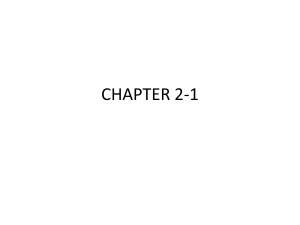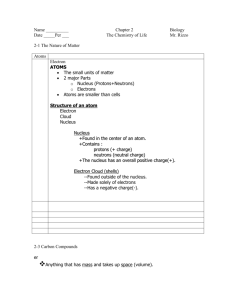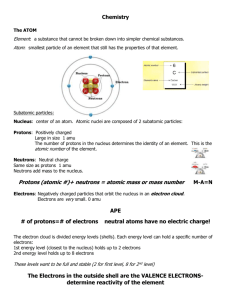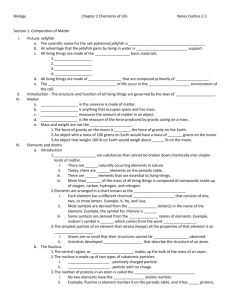Food Science Unit 3 Study Guide
advertisement
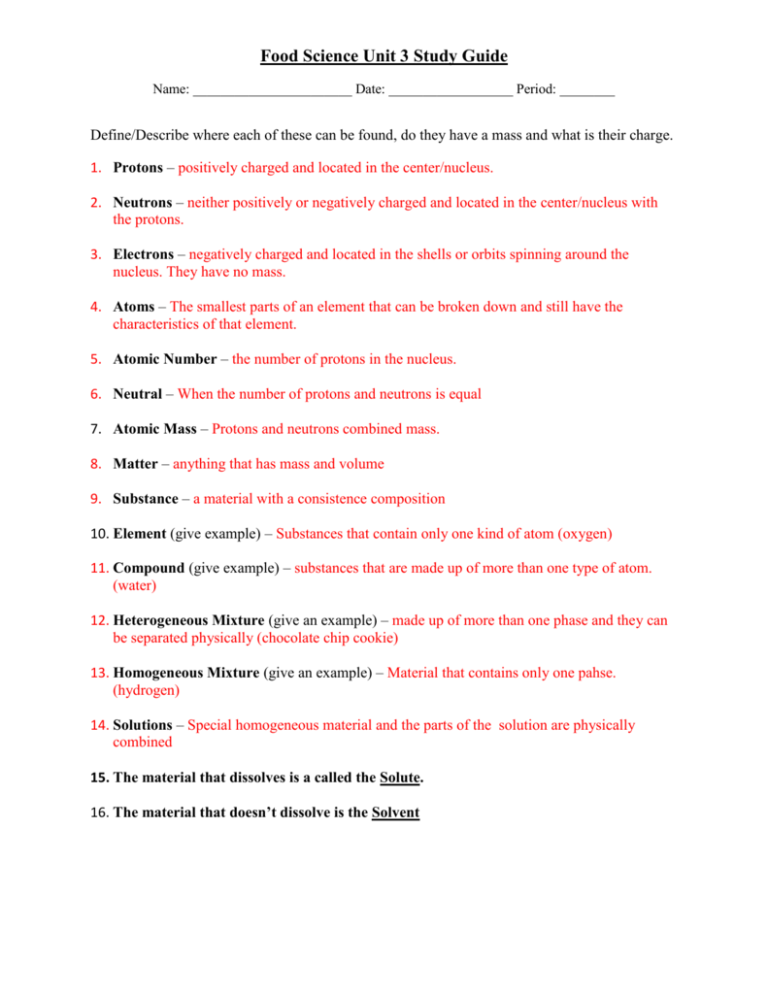
Food Science Unit 3 Study Guide Name: _______________________ Date: __________________ Period: ________ Define/Describe where each of these can be found, do they have a mass and what is their charge. 1. Protons – positively charged and located in the center/nucleus. 2. Neutrons – neither positively or negatively charged and located in the center/nucleus with the protons. 3. Electrons – negatively charged and located in the shells or orbits spinning around the nucleus. They have no mass. 4. Atoms – The smallest parts of an element that can be broken down and still have the characteristics of that element. 5. Atomic Number – the number of protons in the nucleus. 6. Neutral – When the number of protons and neutrons is equal 7. Atomic Mass – Protons and neutrons combined mass. 8. Matter – anything that has mass and volume 9. Substance – a material with a consistence composition 10. Element (give example) – Substances that contain only one kind of atom (oxygen) 11. Compound (give example) – substances that are made up of more than one type of atom. (water) 12. Heterogeneous Mixture (give an example) – made up of more than one phase and they can be separated physically (chocolate chip cookie) 13. Homogeneous Mixture (give an example) – Material that contains only one pahse. (hydrogen) 14. Solutions – Special homogeneous material and the parts of the solution are physically combined 15. The material that dissolves is a called the Solute. 16. The material that doesn’t dissolve is the Solvent Food Science Unit 3 Study Guide Name: _______________________ Date: __________________ Period: ________ 17. Chemical bonds – the forces that hold atoms together Ionic Bonds – The bond formed by the transfer of electrons between atoms. Covalent Bonds – atoms share electrons with each other Double Bond – More than one pair of electrons can be shared when two atoms share two pairs of electrons. 18. Chemical Equation – a written description of a chemical reaction, using symbols and formulas. 19. Periodic Table – a chart that is arranges elements by atomic number into rows and columns according to similarities in their properties. 20. When Hydrogen ion is released, the solution becomes acidic. 21. When Hydroxide ion is released, the solution becomes basic. 22. Dissociated is the breakup of a compound. 23. Acids are found between 0-7 on the PH scale. 24. Bases are found between 7-14 on the PH scale. 25. The body’s “normal” PH should be between 7.2 – 7.3. 26. Ion – an atom or group of atoms that has a positive or negative charge. Like charges repel each other Opposite charges attract Substances with ionic bonds will tend to dissolve in water. One end of the water molecule is slightly positive, whereas the other end is slightly negative. 28. Organic Compounds contain chains or rings of carbon. Most also contain hydrogen and oxygen All the sources of energy in your diet are organic Compounds. (carbohydrates, fats, vitamins & protein) All of these are the main components of your diet. Food Science Unit 3 Study Guide Name: _______________________ Date: __________________ Period: ________ 29. Inorganic compounds either contain no carbon or have only single carbon atoms. Examples of inorganic compounds in your diet… Table Salt, Water, minerals and potassium chloride (no salt) 30. Classes of Organic Compounds Important in Food – Hydrocarbons Alcohols Aldehydes Ketones Acids Amines





